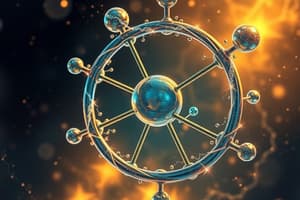Podcast
Questions and Answers
Which of the following is NOT a primary function of carbohydrates in living organisms?
Which of the following is NOT a primary function of carbohydrates in living organisms?
- Cellular communication and recognition
- Enzymatic catalysis (correct)
- Structural components of cell walls
- Short-term energy storage
Which of the following best describes the primary structural difference between saturated and unsaturated fatty acids?
Which of the following best describes the primary structural difference between saturated and unsaturated fatty acids?
- Saturated fatty acids contain phosphate groups, while unsaturated fatty acids do not.
- Unsaturated fatty acids are composed of glycerol and three fatty acids, while saturated fatty acids are not.
- Unsaturated fatty acids are typically found in animals, whereas saturated fatty acids are found in plants.
- Saturated fatty acids contain only single bonds between carbon atoms, while unsaturated fatty acids contain one or more double bonds. (correct)
What is the primary significance of a peptide bond in protein structure?
What is the primary significance of a peptide bond in protein structure?
- It determines the folding pattern of the protein's tertiary structure.
- It stabilizes the double helix structure of DNA.
- It links monosaccharides together to form polysaccharides.
- It links amino acids together to form a polypeptide chain. (correct)
Which level of protein structure is most affected by denaturation?
Which level of protein structure is most affected by denaturation?
Which of the following is a key structural difference between DNA and RNA?
Which of the following is a key structural difference between DNA and RNA?
Which subatomic particle is NOT located in the nucleus of an atom?
Which subatomic particle is NOT located in the nucleus of an atom?
An atom of carbon has an atomic number of 6 and a mass number of 14. How many neutrons does it have?
An atom of carbon has an atomic number of 6 and a mass number of 14. How many neutrons does it have?
Which of the following describes an isotope?
Which of the following describes an isotope?
Which of the following configurations results in a stable atom?
Which of the following configurations results in a stable atom?
Which best describes electronegativity?
Which best describes electronegativity?
A solution with a pH of 2 has how many times more $H^+$ ions than a solution with a pH of 5?
A solution with a pH of 2 has how many times more $H^+$ ions than a solution with a pH of 5?
What is the primary role of a buffer in a biological system?
What is the primary role of a buffer in a biological system?
What is the role of water in a hydrolysis reaction?
What is the role of water in a hydrolysis reaction?
Flashcards
Atomic Composition of Carbohydrates
Atomic Composition of Carbohydrates
Carbohydrates consist of carbon, hydrogen, and oxygen atoms, typically in a 1:2:1 ratio.
Types of Carbohydrates
Types of Carbohydrates
Carbohydrates include monosaccharides, disaccharides, oligosaccharides, and polysaccharides, which differ by number of sugar units.
Structure of Amino Acids
Structure of Amino Acids
Amino acids have a central carbon atom, an amino group, a carboxyl group, a hydrogen atom, and an R group (side chain).
Peptide Bond Importance
Peptide Bond Importance
Signup and view all the flashcards
Difference Between DNA and RNA
Difference Between DNA and RNA
Signup and view all the flashcards
Subatomic particles
Subatomic particles
Signup and view all the flashcards
Isotope
Isotope
Signup and view all the flashcards
Stable atom
Stable atom
Signup and view all the flashcards
Ionic bond
Ionic bond
Signup and view all the flashcards
Covalent bond
Covalent bond
Signup and view all the flashcards
Electronegativity
Electronegativity
Signup and view all the flashcards
pH scale significance
pH scale significance
Signup and view all the flashcards
Buffer significance
Buffer significance
Signup and view all the flashcards
Study Notes
Atomic Structure and Bonding
- Atoms are composed of protons (+ charge), neutrons (no charge), and electrons (- charge). Protons and neutrons reside in the nucleus; electrons orbit the nucleus.
- Atomic number = number of protons; mass number = protons + neutrons. Knowing these, you can calculate the number of each subatomic particle in an atom.
- Isotopes are atoms of the same element with different numbers of neutrons. This alters the mass number.
- Example of an isotopic application in human health: radioactive isotopes are used in medical imaging and cancer treatment (e.g., iodine-131 for thyroid disorders).
- Electron shells have specific capacities: first shell holds 2 electrons, second shell holds 8, and third shell holds 8 (initially).
- A stable atom has all its electron orbitals completely filled.
Ionic and Covalent Bonds
- Ionic bonds form when one atom transfers electrons to another, creating oppositely charged ions that attract. Example: NaCl (sodium chloride).
- Covalent bonds form when atoms share electrons. Example: H₂O (water).
- Electronegativity is an atom's ability to attract electrons in a chemical bond.
- Polar covalent bonds form when electrons are shared unequally due to differences in electronegativity. Water (H₂O) is an example.
- Nonpolar covalent bonds form when electrons are shared equally due to similar electronegativities. An example is H₂ (hydrogen gas).
Water and Solutions
- Hydrogen bonds form between the slightly positive hydrogen atoms of one water molecule and the slightly negative oxygen atom of another. This polarity gives water unique properties.
- An electrolyte is a substance that dissociates in water to form ions, which are essential for many bodily functions.
- Acids release H+ ions in solution, while bases release OH– ions.
- pH is inversely related to H+ concentration. A lower pH (e.g. 2) signifies a higher H+ concentration compared to a higher pH (e.g. 4). A whole number change in pH represents a 10-fold difference in H+ concentration.
- A buffer solution resists changes in pH by absorbing or releasing H+ ions. Important for biological systems to maintain stable pH.
Organic Molecules
- Carbon atoms can form four covalent bonds, a crucial feature for the diversity of organic molecules.
- Organic molecules are composed primarily of carbon and hydrogen, with other elements like oxygen, nitrogen, and phosphorus also present.
- Functional groups are specific arrangements of atoms within molecules that give them characteristic chemical properties. These groups determine how molecules interact.
- Monomers are small, repeating units; polymers are large molecules formed from many monomers linked together.
- Reactants are substances that undergo a chemical reaction, and products are the resulting substances.
- Dehydration reactions link monomers together and release water; hydrolysis reactions break polymers apart by adding water.
- Four categories of biological macromolecules: carbohydrates, lipids, proteins, and nucleic acids.
Carbohydrates
- Atomic composition is primarily carbon, hydrogen, and oxygen.
- Functions include energy storage, structural support, and cell recognition.
- Examples include sugars, starches, and cellulose.
- Subcategories: monosaccharides, disaccharides, oligosaccharides, and polysaccharides.
Lipids
- Atomic composition: primarily carbon, hydrogen, and oxygen (with less oxygen than carbohydrates).
- Functions: energy storage, insulation, and structural components of cell membranes.
- Examples: fats, oils, phospholipids, and steroids.
- Subcategories: fatty acids, phospholipids, and steroids.
Proteins
- Atomic composition: carbon, hydrogen, oxygen, nitrogen, and sometimes sulfur.
- Functions: structural support, enzymes, transport, hormones, and defense.
- Examples: keratin, hemoglobin, enzymes.
- Structure: amino acid—> polypeptide chain—> protein
- Peptide bonds link amino acids.
- Protein structure (primary, secondary, tertiary, quaternary) describes the organization of amino acid chains. Denaturation alters a protein's shape, rendering it inactive.
- Protein denaturation examples: heat, pH changes, etc.
Nucleic Acids
- Atomic composition: carbon, hydrogen, oxygen, nitrogen, and phosphorus.
- Functions: store and transmit genetic information.
- Examples: DNA, RNA.
- DNA and RNA differ structurally and functionally.
- Nucleotide structure: sugar, phosphate group, and a nitrogenous base.
- Nitrogenous bases: adenine, guanine, cytosine, and thymine (or uracil in RNA). They have specific pairing rules.
Studying That Suits You
Use AI to generate personalized quizzes and flashcards to suit your learning preferences.




